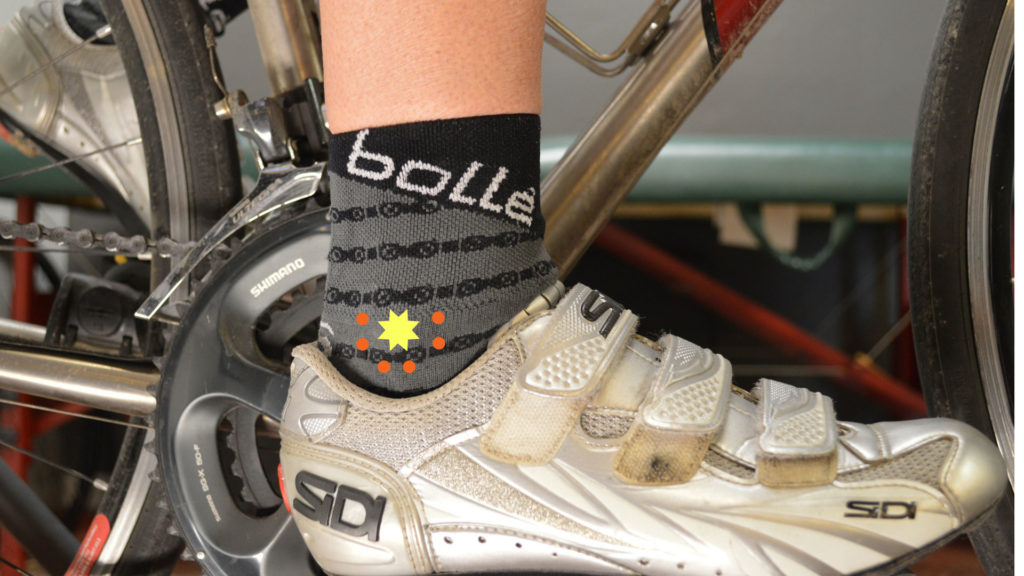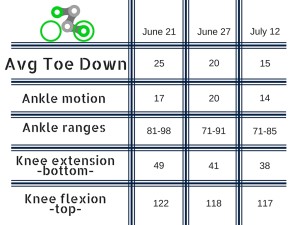Bike Fit Case Study: the slow ankle
I happened upon a great example for a bike fit case study. Recently I noted some interesting research article on the blog (Stable Feet, Mobile Hips) that was looking at what changed in our lower body joint mechanics when we drastically changed crank length. For example, if we went from 140mm cranks to 200mm ones, how much change in total range of motion did we see at the hip, knee, and ankle? Did the speed of movement at these joints change ? The article found that measurements at the ankle were changed the least of the lower body joints.This confirmed what I've seen for years in my bike fitting practice that the ankles and feet are generally 'slow-adapters'. I had a textbook example of this with a recent client that fits perfectly into the bike fit case study series.This client is a serious cyclist who rides 5-6 days a week, routinely rides 40-60 miles a day and has some long rides with lots of climbing coming up. Lately she's been having front of the knee pain when she climbs though - to the point where she's in significant discomfort just half way through getting up the local hills.To cut right to the chase after assessing and measuring her on and off the bike, it became clear that she tended to toe-down a lot -- this is also called ankle plantar flexion -- throughout her pedal stroke. Her ankle averaged being 25° toe down - so at times she'd be toed down a bit more or less than that.Toeing down increases knee flexion throughout the pedaling cycling. In bike fitting the angle of the knee is usually measured and referenced at the bottom of the pedal stroke -- you'll often hear that a rider "has a knee angle of 36°" at the bottom of the pedal stroke.But the more critical time for more knee bend and it's effect on knee pain is at the top of the pedal stroke when the knee is bent maximally and there is also significant load being placed through the tissues - this is when the power phase of our stroke begins. We don't have the same amount of load at the bottom of the stroke and the combination of maximal knee flexion plus load is the recipe for knee tissue injury.At our first appointment on June 21st her toe-down posture averaged 25° as noted before, her total ankle range of motion throughout the stroke was ~17° moving from a closed (or dorsiflexed) position of 81° to an open (plantarflexed) position of 98°. Her knee extension at the bottom of the pedal stroke was 48-49° and knee flexion at the top of the stroke was 122°.This represents a fairly large amount of "toeing down" as well as too much knee flexion -- at the top or bottom of the pedal stroke.On June 27th after her body had some time to adapt to the changes, her average toe down was now 20°, total ankle ROM was 20°, moving from 71° to 91°. Extension at bottom was 41° and 118° at the top of the stroke.On July 12th after more adaptation had occurred, but no further changes to saddle height or clear position, her toe down average was 15°, total ankle motion was 14° moving from 71° to 85°. Knee extension at bottom was 38-39°, knee flexion at the top had dropped incrementally to 117°.
I had a textbook example of this with a recent client that fits perfectly into the bike fit case study series.This client is a serious cyclist who rides 5-6 days a week, routinely rides 40-60 miles a day and has some long rides with lots of climbing coming up. Lately she's been having front of the knee pain when she climbs though - to the point where she's in significant discomfort just half way through getting up the local hills.To cut right to the chase after assessing and measuring her on and off the bike, it became clear that she tended to toe-down a lot -- this is also called ankle plantar flexion -- throughout her pedal stroke. Her ankle averaged being 25° toe down - so at times she'd be toed down a bit more or less than that.Toeing down increases knee flexion throughout the pedaling cycling. In bike fitting the angle of the knee is usually measured and referenced at the bottom of the pedal stroke -- you'll often hear that a rider "has a knee angle of 36°" at the bottom of the pedal stroke.But the more critical time for more knee bend and it's effect on knee pain is at the top of the pedal stroke when the knee is bent maximally and there is also significant load being placed through the tissues - this is when the power phase of our stroke begins. We don't have the same amount of load at the bottom of the stroke and the combination of maximal knee flexion plus load is the recipe for knee tissue injury.At our first appointment on June 21st her toe-down posture averaged 25° as noted before, her total ankle range of motion throughout the stroke was ~17° moving from a closed (or dorsiflexed) position of 81° to an open (plantarflexed) position of 98°. Her knee extension at the bottom of the pedal stroke was 48-49° and knee flexion at the top of the stroke was 122°.This represents a fairly large amount of "toeing down" as well as too much knee flexion -- at the top or bottom of the pedal stroke.On June 27th after her body had some time to adapt to the changes, her average toe down was now 20°, total ankle ROM was 20°, moving from 71° to 91°. Extension at bottom was 41° and 118° at the top of the stroke.On July 12th after more adaptation had occurred, but no further changes to saddle height or clear position, her toe down average was 15°, total ankle motion was 14° moving from 71° to 85°. Knee extension at bottom was 38-39°, knee flexion at the top had dropped incrementally to 117°. More importantly she went on an 80 mile ride with 7200 feet of climbing and had no pain during the ride but still had soreness afterwards. This is still a "win" though since we'd managed to change the three critical variables of pain -- frequency, intensity, and duration.The most critical change as it relates to her knee pain was that we had reduced the amount of knee flexion she was experiencing at the top and bottom of her pedal stroke. Since she already was toeing down a fair bit, if I had just jacked her seat up 4 centimeters to get her to 37-38° of knee extension (at the bottom) from the 49° mark we had started at, her mechanics were likely to change for the worse.We still made it to 38° of knee extension at the bottom and 117° flexion at the top and only changed her saddle height that one time. The real change came from allowing her ankles and feet to slowly adapt and they fundamentally changed the range of motion that they worked in. Notice how the ankle first expanded it's total range of motion by the second visit to 20° but dropped it's "closed" position to 71°. Then by the third visit, it had tightened up the range again to 14° but kept its starting position of 71°.This is the struggle with bike fitting -- it takes restraint. If we had tried to move too fast and correct her too much too soon there's a good chance we would create another problem, like strain her Achilles or irritate her low back.It took 3 weeks for all the changes to come full circle at the ankle. We had to move slowly and let her body come along at its own pace.
More importantly she went on an 80 mile ride with 7200 feet of climbing and had no pain during the ride but still had soreness afterwards. This is still a "win" though since we'd managed to change the three critical variables of pain -- frequency, intensity, and duration.The most critical change as it relates to her knee pain was that we had reduced the amount of knee flexion she was experiencing at the top and bottom of her pedal stroke. Since she already was toeing down a fair bit, if I had just jacked her seat up 4 centimeters to get her to 37-38° of knee extension (at the bottom) from the 49° mark we had started at, her mechanics were likely to change for the worse.We still made it to 38° of knee extension at the bottom and 117° flexion at the top and only changed her saddle height that one time. The real change came from allowing her ankles and feet to slowly adapt and they fundamentally changed the range of motion that they worked in. Notice how the ankle first expanded it's total range of motion by the second visit to 20° but dropped it's "closed" position to 71°. Then by the third visit, it had tightened up the range again to 14° but kept its starting position of 71°.This is the struggle with bike fitting -- it takes restraint. If we had tried to move too fast and correct her too much too soon there's a good chance we would create another problem, like strain her Achilles or irritate her low back.It took 3 weeks for all the changes to come full circle at the ankle. We had to move slowly and let her body come along at its own pace.
